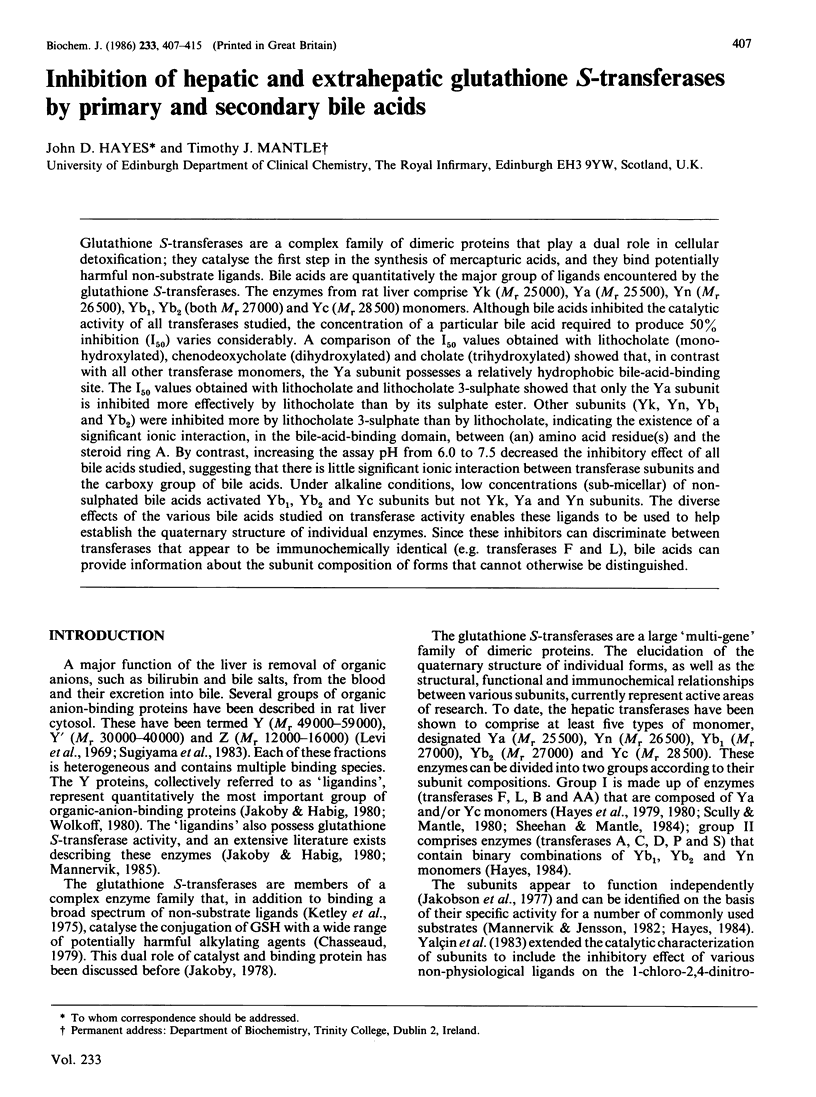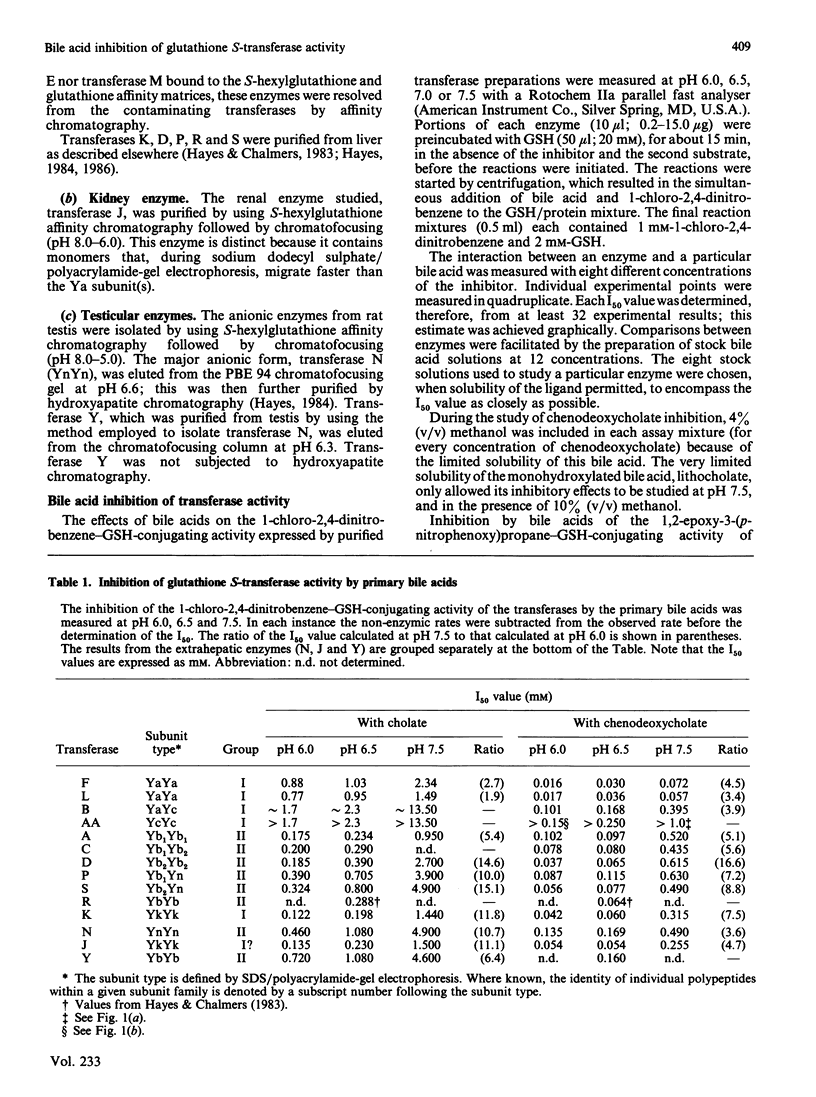Abstract
Glutathione S-transferases are a complex family of dimeric proteins that play a dual role in cellular detoxification; they catalyse the first step in the synthesis of mercapturic acids, and they bind potentially harmful non-substrate ligands. Bile acids are quantitatively the major group of ligands encountered by the glutathione S-transferases. The enzymes from rat liver comprise Yk (Mr 25 000), Ya (Mr 25 500), Yn (Mr 26 500), Yb1, Yb2 (both Mr 27 000) and Yc (Mr 28 500) monomers. Although bile acids inhibited the catalytic activity of all transferases studied, the concentration of a particular bile acid required to produce 50% inhibition (I50) varies considerably. A comparison of the I50 values obtained with lithocholate (monohydroxylated), chenodeoxycholate (dihydroxylated) and cholate (trihydroxylated) showed that, in contrast with all other transferase monomers, the Ya subunit possesses a relatively hydrophobic bile-acid-binding site. The I50 values obtained with lithocholate and lithocholate 3-sulphate showed that only the Ya subunit is inhibited more effectively by lithocholate than by its sulphate ester. Other subunits (Yk, Yn, Yb1 and Yb2) were inhibited more by lithocholate 3-sulphate than by lithocholate, indicating the existence of a significant ionic interaction, in the bile-acid-binding domain, between (an) amino acid residue(s) and the steroid ring A. By contrast, increasing the assay pH from 6.0 to 7.5 decreased the inhibitory effect of all bile acids studied, suggesting that there is little significant ionic interaction between transferase subunits and the carboxy group of bile acids. Under alkaline conditions, low concentrations (sub-micellar) of nonsulphated bile acids activated Yb1, Yb2 and Yc subunits but not Yk, Ya and Yn subunits. The diverse effects of the various bile acids studied on transferase activity enables these ligands to be used to help establish the quaternary structure of individual enzymes. Since these inhibitors can discriminate between transferases that appear to be immunochemically identical (e.g. transferases F and L), bile acids can provide information about the subunit composition of forms that cannot otherwise be distinguished.
Full text
PDF








Selected References
These references are in PubMed. This may not be the complete list of references from this article.
- Boyer T. D., Vessey D. A., Holcomb C., Saley N. Studies of the relationship between the catalytic activity and binding of non-substrate ligands by the glutathione S-transferases. Biochem J. 1984 Jan 1;217(1):179–185. doi: 10.1042/bj2170179. [DOI] [PMC free article] [PubMed] [Google Scholar]
- Carne T., Tipping E., Ketterer B. The binding and catalytic activities of forms of ligandin after modification of its thiol groups. Biochem J. 1979 Feb 1;177(2):433–439. doi: 10.1042/bj1770433. [DOI] [PMC free article] [PubMed] [Google Scholar]
- Chasseaud L. F. The role of glutathione and glutathione S-transferases in the metabolism of chemical carcinogens and other electrophilic agents. Adv Cancer Res. 1979;29:175–274. doi: 10.1016/s0065-230x(08)60848-9. [DOI] [PubMed] [Google Scholar]
- Fischer C. D., Cooper N. S., Rothschild M. A., Mosbach E. H. Effect of dietary chenodeoxycholic acid and lithocholic acid in the rabbit. Am J Dig Dis. 1974 Oct;19(10):877–886. doi: 10.1007/BF01076210. [DOI] [PubMed] [Google Scholar]
- Habig W. H., Jakoby W. B. Glutathione S-transferases (rat and human). Methods Enzymol. 1981;77:218–231. doi: 10.1016/s0076-6879(81)77029-0. [DOI] [PubMed] [Google Scholar]
- Habig W. H., Pabst M. J., Jakoby W. B. Glutathione S-transferase AA from rat liver. Arch Biochem Biophys. 1976 Aug;175(2):710–716. doi: 10.1016/0003-9861(76)90563-4. [DOI] [PubMed] [Google Scholar]
- Habig W. H., Pabst M. J., Jakoby W. B. Glutathione S-transferases. The first enzymatic step in mercapturic acid formation. J Biol Chem. 1974 Nov 25;249(22):7130–7139. [PubMed] [Google Scholar]
- Hayes J. D., Chalmers J. Bile acid inhibition of basic and neutral glutathione S-transferases in rat liver. Biochem J. 1983 Dec 1;215(3):581–588. doi: 10.1042/bj2150581. [DOI] [PMC free article] [PubMed] [Google Scholar]
- Hayes J. D., Clarkson G. H. Purification and characterization of three forms of glutathione S-transferase A. A comparative study of the major YaYa-, YbYb- and YcYc-containing glutathione S-transferases. Biochem J. 1982 Dec 1;207(3):459–470. doi: 10.1042/bj2070459. [DOI] [PMC free article] [PubMed] [Google Scholar]
- Hayes J. D. Purification and characterization of glutathione S-transferases P, S and N. Isolation from rat liver of Yb1 Yn protein, the existence of which was predicted by subunit hybridization in vitro. Biochem J. 1984 Dec 15;224(3):839–852. doi: 10.1042/bj2240839. [DOI] [PMC free article] [PubMed] [Google Scholar]
- Hayes J. D. Rat liver glutathione S-transferases. A study of the structure of the basic YbYb-containing enzymes. Biochem J. 1983 Sep 1;213(3):625–633. doi: 10.1042/bj2130625. [DOI] [PMC free article] [PubMed] [Google Scholar]
- Hayes J. D., Strange R. C., Percy-Robb I. W. Cholic acid binding by glutathione S-transferases from rat liver cytosol. Biochem J. 1980 Jan 1;185(1):83–87. doi: 10.1042/bj1850083. [DOI] [PMC free article] [PubMed] [Google Scholar]
- Hayes J. D., Strange R. C., Percy-Robb I. W. Identification of two lithocholic acid-binding proteins. Separation of ligandin from glutathione S-transferase B. Biochem J. 1979 Sep 1;181(3):699–708. doi: 10.1042/bj1810699. [DOI] [PMC free article] [PubMed] [Google Scholar]
- Jakobson I., Askelöf P., Warholm M., Mannervik B. A steady-state-kinetic random mechanism for glutathione S-transferase A from rat liver. A model involving kinetically significant enzyme-product complexes in the forward reaction. Eur J Biochem. 1977 Jul 15;77(2):253–262. doi: 10.1111/j.1432-1033.1977.tb11664.x. [DOI] [PubMed] [Google Scholar]
- Jakoby W. B. The glutathione S-transferases: a group of multifunctional detoxification proteins. Adv Enzymol Relat Areas Mol Biol. 1978;46:383–414. doi: 10.1002/9780470122914.ch6. [DOI] [PubMed] [Google Scholar]
- Javitt N. B., Emerman S. Effect of sodium taurolithocholate on bile flow and bile acid exeretion. J Clin Invest. 1968 May;47(5):1002–1014. doi: 10.1172/JCI105790. [DOI] [PMC free article] [PubMed] [Google Scholar]
- Kakis G., Yousef I. M. Pathogenesis of lithocholate- and taurolithocholate-induced intrahepatic cholestasis in rats. Gastroenterology. 1978 Oct;75(4):595–607. [PubMed] [Google Scholar]
- Ketley J. N., Habig W. H., Jakoby W. B. Binding of nonsubstrate ligands to the glutathione S-transferases. J Biol Chem. 1975 Nov 25;250(22):8670–8673. [PubMed] [Google Scholar]
- Lai H. C., Li N., Weiss M. J., Reddy C. C., Tu C. P. The nucleotide sequence of a rat liver glutathione S-transferase subunit cDNA clone. J Biol Chem. 1984 May 10;259(9):5536–5542. [PubMed] [Google Scholar]
- Levi A. J., Gatmaitan Z., Arias I. M. Two hepatic cytoplasmic protein fractions, Y and Z, and their possible role in the hepatic uptake of bilirubin, sulfobromophthalein, and other anions. J Clin Invest. 1969 Nov;48(11):2156–2167. doi: 10.1172/JCI106182. [DOI] [PMC free article] [PubMed] [Google Scholar]
- Mannervik B., Jensson H. Binary combinations of four protein subunits with different catalytic specificities explain the relationship between six basic glutathione S-transferases in rat liver cytosol. J Biol Chem. 1982 Sep 10;257(17):9909–9912. [PubMed] [Google Scholar]
- Mannervik B. The isoenzymes of glutathione transferase. Adv Enzymol Relat Areas Mol Biol. 1985;57:357–417. doi: 10.1002/9780470123034.ch5. [DOI] [PubMed] [Google Scholar]
- PALMER R. H. HAEMOLYTIC EFFECTS OF STEROIDS. Nature. 1964 Mar 14;201:1134–1135. doi: 10.1038/2011134b0. [DOI] [PubMed] [Google Scholar]
- Pattinson N. Purification by affinity chromatography of glutathione S-transferases A and C from rat liver cytosol. Anal Biochem. 1981 Aug;115(2):424–427. doi: 10.1016/0003-2697(81)90028-2. [DOI] [PubMed] [Google Scholar]
- Pickett C. B., Telakowski-Hopkins C. A., Ding G. J., Argenbright L., Lu A. Y. Rat liver glutathione S-transferases. Complete nucleotide sequence of a glutathione S-transferase mRNA and the regulation of the Ya, Yb, and Yc mRNAs by 3-methylcholanthrene and phenobarbital. J Biol Chem. 1984 Apr 25;259(8):5182–5188. [PubMed] [Google Scholar]
- STEWART F. S., PEARSON A. E. Estimation of mouse tumour blood volumes employing a radioactive isotope technique. Nature. 1960 Apr 16;186:250–251. doi: 10.1038/186250b0. [DOI] [PubMed] [Google Scholar]
- Scully N. C., Mantle T. J. Studies on the nature of the multiple forms of the glutathione S-transferases. Biochem Soc Trans. 1980 Aug;8(4):451–452. doi: 10.1042/bst0080451. [DOI] [PubMed] [Google Scholar]
- Sheehan D., Mantle T. J. Evidence for two forms of ligandin (YaYa dimers of glutathione S-transferase) in rat liver and kidney. Biochem J. 1984 Mar 15;218(3):893–897. doi: 10.1042/bj2180893. [DOI] [PMC free article] [PubMed] [Google Scholar]
- Strange R. C., Cramb R., Hayes J. D., Percy-Robb I. W. Partial purification of two lithocholic acid-binding proteins from rat liver 100 000g supernatants. Biochem J. 1977 Sep 1;165(3):425–429. doi: 10.1042/bj1650425. [DOI] [PMC free article] [PubMed] [Google Scholar]
- Sugiyama Y., Yamada T., Kaplowitz N. Newly identified bile acid binders in rat liver cytosol. Purification and comparison with glutathione S-transferases. J Biol Chem. 1983 Mar 25;258(6):3602–3607. [PubMed] [Google Scholar]
- Tahir M. K., Guthenberg C., Mannervik B. Inhibitors for distinction of three types of human glutathione transferase. FEBS Lett. 1985 Feb 25;181(2):249–252. doi: 10.1016/0014-5793(85)80269-6. [DOI] [PubMed] [Google Scholar]
- Tipping E., Ketterer B., Christodoulides L., Enderby G. The non-convalent binding of small molecules by ligandin. Interactions with steroids and their conjugates, fatty acids, bromosulphophthalein carcinogens, glutathione and realted compounds. Eur J Biochem. 1976 Aug 16;67(2):583–590. doi: 10.1111/j.1432-1033.1976.tb10724.x. [DOI] [PubMed] [Google Scholar]
- Vessey D. A., Zakim D. Inhibition of glutathione S-transferase by bile acids. Biochem J. 1981 Aug 1;197(2):321–325. doi: 10.1042/bj1970321. [DOI] [PMC free article] [PubMed] [Google Scholar]
- Wolkoff A. W. The glutathione S-transferases: their role in the transport of organic anions from blood to bile. Int Rev Physiol. 1980;21:150–169. [PubMed] [Google Scholar]
- Yalçin S., Jensson H., Mannervik B. A set of inhibitors for discrimination between the basic isozymes of glutathione transferase in rat liver. Biochem Biophys Res Commun. 1983 Jul 29;114(2):829–834. doi: 10.1016/0006-291x(83)90856-2. [DOI] [PubMed] [Google Scholar]


